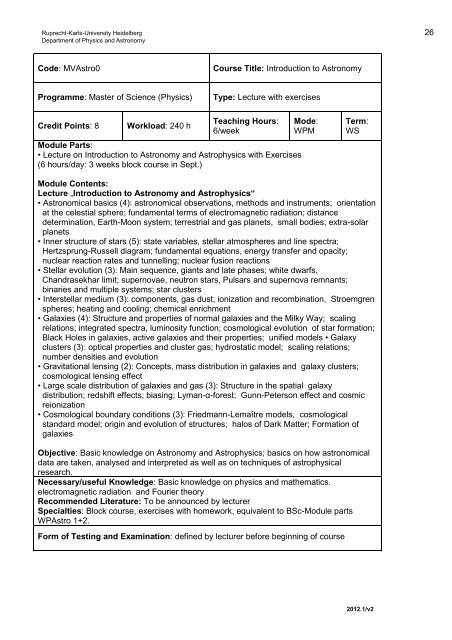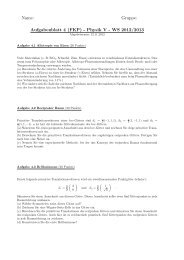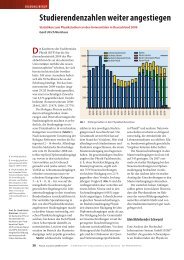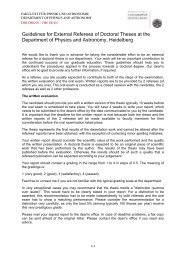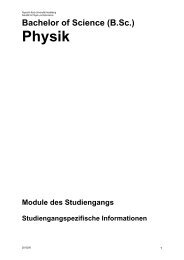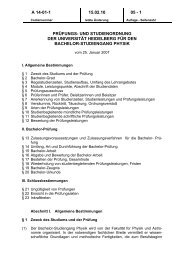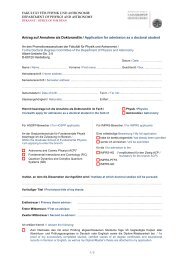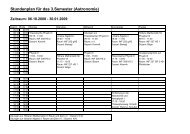Master - Fakultät für Physik und Astronomie
Master - Fakultät für Physik und Astronomie
Master - Fakultät für Physik und Astronomie
Create successful ePaper yourself
Turn your PDF publications into a flip-book with our unique Google optimized e-Paper software.
Ruprecht-Karls-University Heidelberg 26<br />
Department of Physics and Astronomy<br />
Code: MVAstro0<br />
Course Title: Introduction to Astronomy<br />
Programme: <strong>Master</strong> of Science (Physics)<br />
Type: Lecture with exercises<br />
Credit Points: 8<br />
Workload: 240 h<br />
Teaching Hours:<br />
6/week<br />
Module Parts:<br />
• Lecture on Introduction to Astronomy and Astrophysics with Exercises<br />
(6 hours/day: 3 weeks block course in Sept.)<br />
Mode:<br />
WPM<br />
Term:<br />
WS<br />
Module Contents:<br />
Lecture „Introduction to Astronomy and Astrophysics“<br />
• Astronomical basics (4): astronomical observations, methods and instruments; orientation<br />
at the celestial sphere; f<strong>und</strong>amental terms of electromagnetic radiation; distance<br />
determination, Earth-Moon system; terrestrial and gas planets, small bodies; extra-solar<br />
planets<br />
• Inner structure of stars (5): state variables, stellar atmospheres and line spectra;<br />
Hertzsprung-Russell diagram; f<strong>und</strong>amental equations, energy transfer and opacity;<br />
nuclear reaction rates and tunnelling; nuclear fusion reactions<br />
• Stellar evolution (3): Main sequence, giants and late phases; white dwarfs,<br />
Chandrasekhar limit; supernovae, neutron stars, Pulsars and supernova remnants;<br />
binaries and multiple systems; star clusters<br />
• Interstellar medium (3): components, gas dust; ionization and recombination, Stroemgren<br />
spheres; heating and cooling; chemical enrichment<br />
• Galaxies (4): Structure and properties of normal galaxies and the Milky Way; scaling<br />
relations; integrated spectra, luminosity function; cosmological evolution of star formation;<br />
Black Holes in galaxies, active galaxies and their properties; unified models • Galaxy<br />
clusters (3): optical properties and cluster gas; hydrostatic model; scaling relations;<br />
number densities and evolution<br />
• Gravitational lensing (2): Concepts, mass distribution in galaxies and galaxy clusters;<br />
cosmological lensing effect<br />
• Large scale distribution of galaxies and gas (3): Structure in the spatial galaxy<br />
distribution; redshift effects; biasing; Lyman-α-forest; Gunn-Peterson effect and cosmic<br />
reionization<br />
• Cosmological bo<strong>und</strong>ary conditions (3): Friedmann-Lemaître models, cosmological<br />
standard model; origin and evolution of structures; halos of Dark Matter; Formation of<br />
galaxies<br />
Objective: Basic knowledge on Astronomy and Astrophysics; basics on how astronomical<br />
data are taken, analysed and interpreted as well as on techniques of astrophysical<br />
research.<br />
Necessary/useful Knowledge: Basic knowledge on physics and mathematics.<br />
electromagnetic radiation and Fourier theory<br />
Recommended Literature: To be announced by lecturer<br />
Specialties: Block course, exercises with homework, equivalent to BSc-Module parts<br />
WPAstro 1+2.<br />
Form of Testing and Examination: defined by lecturer before beginning of course<br />
2012.1/v2


